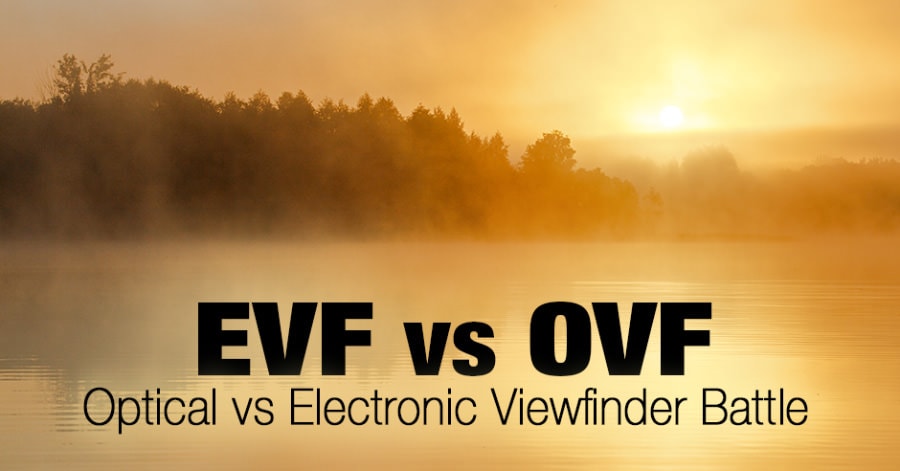Which is better, EVF vs OVF? Electronic viewfinder or
optical viewfinder?

Mirrorless cameras offer electronic viewfinders; DSLRs
feature optical viewfinders. And with the rise of mirrorless cameras, it’s an
increasingly important comparison.
In fact:
For many photographers, viewfinder differences can be the deciding factor between mirrorless and DSLR cameras.
So in this article, I’m going to break it all down for
you. You’ll discover the pros and cons of EVFs and OVFs. And you’ll come away
knowing which viewfinder is best.
Let’s dive right in.
What is an OVF?
First things first:
What exactly is an OVF?
OVF stands for optical viewfinder. Now, the viewfinder is the part of the camera that you look through to check out the scene. When you put one eye up to the camera to preview your shot, you’re looking through an optical viewfinder.
Here’s the most important fact about OVFs:
When you look through an optical viewfinder, you’re looking through the lens. You’re seeing what the lens sees. This is what you find on all DSLR cameras.

Compare this to the alternative, EVFs:
What is an EVF?
EVF stands for electronic viewfinder.
Unlike an OVF, an EVF doesn’t show you a view through
the lens.
Instead, EVFs show you what the camera sensor sees–because it’s a little screen inside your camera. Which means you don’t get a simple, straightforward view of the scene. You’re looking at the scene once it’s been processed by the camera–so you essentially see it already exposed.
You can find electronic viewfinders in some (but not
all) mirrorless cameras.

OVF vs EVF: Advantages of an Optical Viewfinder
Optical viewfinders feature several clear advantages over electronic viewfinders.
1. No Shutter Lag
First, optical viewfinders have absolutely no shutter lag–they show you exactly what the lens is seeing, as it sees it.
Electronic viewfinders, on the other hand, do have a slight lag. On the best EVFs, this is negligible, and won’t make any difference to your shooting. But if you purchase a cheaper or older mirrorless body, you may get stuck with an electronic viewfinder that lags behind the scene, and makes tracking moving subjects especially difficult.
2. Always On
Second, optical viewfinders are ‘on’ all the time.
In other words, you can look through an optical
viewfinder whenever you like–even if your camera is powered down. Electronic
viewfinders, on the other hand, go black when the camera is turned off. And
they take a few moments (e.g., 1-2 seconds) to start up once the camera is
turned on.
This split-second delay can make a difference to action photographers, who sometimes need to power on their camera while tracking a moving subject.
3. Higher Optical Quality
Third, optical viewfinders offer better picture quality
compared to electronic viewfinders. The viewfinder is clearer, because you’re
seeing a true image, not a screen. And the viewfinder features better dynamic
range–again, because the image isn’t being displayed electronically.
Electronic viewfinders, however, are showing you a screen. And that screen’s picture quality depends on the resolution of the EVF, as well as the dynamic range of the screen and the camera sensor.
4. Zero Energy Consumption
Finally, optical viewfinders are electronics free–which
mean they don’t drain batteries.
Electronic viewfinders suck power, and this decreases
the battery life of the camera. The short battery life of mirrorless cameras
(which is due in part due to the EVF, but also due to the more compact
batteries mirrorless cameras use) is a big selling point for DSLRs.
Now let’s turn to the benefits of an electronic
viewfinder:

EVF vs OVF: Advantages of an Electronic Viewfinder
Here’s one of the biggest benefits of an electronic viewfinder:
1. What You See Is What You Get
EVFs give a more accurate display of your final photo.
When you see an EVF image, it’s much closer to what
you’ll see on your computer screen once you’ve taken the shot. It shows you a
decent approximation of the final exposure, the aperture, and more.
Now, it’s not perfect. But it does a far better job of
showing the scene than an optical viewfinder, which doesn’t show exposure and
doesn’t have an automatic depth of field preview.
This makes it much easier to take photos without needing to constantly check your LCD (known as chimping). And it allows you to feel much more confident in your final images during a shoot.
2. Computer Like Experience
Second, EVFs sport all sorts of cool features that OVFs
lack.
Some EVFs show live histograms. Some show levels, that tell you whether your image is straight. Others give focus peaking, which allows you to see, on the viewfinder image, which area of the photo is sharp.
Related: Nikon D6300 vs D6500 – What is the Difference?
These are incredibly useful during a shoot. You can check your exposure in real time with the live histogram. You can make sure you’ve nailed focus with the focus peaking feature. And you can make sure your horizons are perfectly straight with the level.
3. 100% Coverage
Third, EVFs give 100% viewfinder coverage. In other
words, when you look through an electronic viewfinder, you see the full photo.
But optical viewfinders don’t often always offer this feature. In entry-level Canon DSLRs, for instance, viewfinder coverage is pretty consistently 95% of the frame. This may not seem like a big deal, but it can result in unwanted elements entering your frame without you noticing.
4. No Mirror Backouts
Finally, the best electronic viewfinders offer
continuous displays. They don’t have viewfinder
blackout (which is a problem with OVFs).
You see, on DSLRs, when you take a photo the mirror
flips up–and you have a moment of blackness. This isn’t apparent when shooting
with high shutter speeds. But when you do longer exposures, the screen will go
black, and this can be frustrating for anyone trying to evaluate the scene in
front of them.

EVF vs OVF: Which is the Winner?
Now you understand the benefits and drawbacks to both
electronic viewfinders and optical viewfinders.
But which one is better? Which is superior?
Clearly, both have reasons going for them. OVFs have
zero lag and better clarity. EVFs offer previewing and other fancy accessories.
However, I think that modern EVFs edge out OVFs–and the
gap will increase as EVF technology gets better.
The previews offered by EVFs are just too valuable. As
are the focus peaking, live histograms, and more.
So in the battle of EVF vs OVF…

